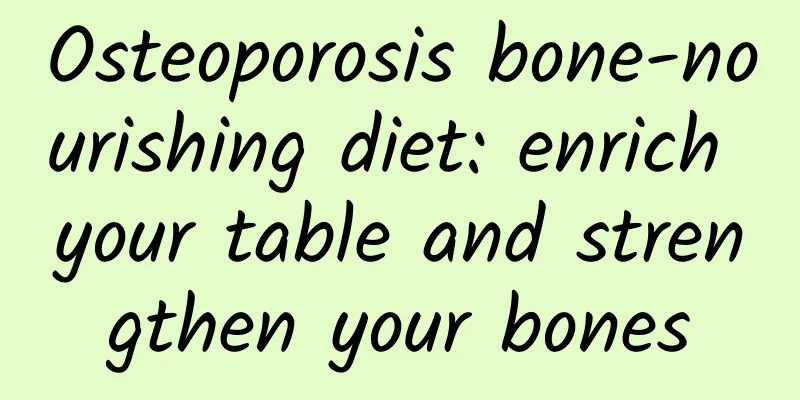Osteoporosis bone-nourishing diet: enrich your table and strengthen your bones

|
Author: Jia Weili Department of Neurology, Beijing Electric Power Hospital Reviewer: Li Ling, Chief Physician, Department of Endocrinology, Beijing Electric Power Hospital When we talk about osteoporosis, most people first think of calcium supplements, but did you know? Waiting until you are old to think of calcium supplements will not reverse the bone mass that has been reduced, nor can it cure osteoporosis that has already formed. If you want to keep your bones healthy when you are old, you must start laying a good foundation when you are young. In addition to exercise, more sun exposure and medication, a proper diet can also play an important role in the prevention and management of osteoporosis. By consuming foods rich in key nutrients, you can provide the necessary support for your bones and reduce the risk of fractures. Let's take a look at the relationship between diet and osteoporosis, and how to keep your bones healthy through a bone-nourishing diet. Calcium: The building block of bones Calcium is a key nutrient for building strong bones. The recommended daily calcium intake for young and middle-aged Chinese residents is 800 mg (elemental calcium), and the recommended daily intake for middle-aged and elderly people over 50 years old, those in the middle and late stages of pregnancy and breastfeeding is 1000-1200 mg. The maximum tolerable intake is 2000 mg. When dietary intake is insufficient, calcium supplements are given. What foods can you eat to get enough calcium? 1. Dairy products: Milk, yogurt and cheese are high-quality sources of calcium. A cup of milk contains about 300 mg of calcium, while a cup of yogurt provides about 250 mg of calcium. 2. Vegetables: Some vegetables are also rich in calcium, such as broccoli, spinach, kale, etc. Try to choose dark green vegetables, which usually contain more calcium. 3. Beans and soy products: Soybeans, black beans, soy milk, etc. are all good sources of calcium. You can also consider increasing your intake of tofu, soy milk and other soy products. However, please note that patients with hypercalcemia and hypercalciuria should avoid calcium supplementation; calcium supplementation should be appropriate, and excessive doses of calcium supplementation may increase the risk of kidney stones and cardiovascular disease. You can also consult a professional doctor to determine the daily amount of calcium supplementation based on your specific situation. Figure 1 Copyright image, no permission to reprint Vitamin D: Promotes calcium absorption Vitamin D plays a vital role in bone health. It helps the body absorb and use calcium and maintains healthy bones. Insufficient vitamin D may also lead to secondary hyperparathyroidism and cause or worsen osteoporosis. Sunlight is the best source of vitamin D, but we can also get vitamin D through our diet. 1. Fish: Oily fish such as salmon, tuna and cod are good sources of vitamin D. Try to eat fish 2 to 3 times a week to get enough vitamin D. 2. Eggs: The yolk is the part rich in vitamin D. Each egg contains 1 to 2 µg of vitamin D. 3. Vegetables and fruits: Broccoli, carrots, spinach, eggplant, pomegranate, dragon fruit, apples, etc. all contain a certain amount of vitamin D. 4. Vitamin D-fortified foods: Certain foods such as milk, yogurt, orange juice, and cereals may be fortified with vitamin D. You can check the label to determine if the product is fortified. Figure 2 Copyright image, no permission to reprint Protein: The building block of bones Proteins are an important building block of bone tissue. They provide essential nutrients to bones and promote bone growth and repair. Ensuring adequate protein intake is essential for maintaining bone health. 1. Lean meat and poultry: Chicken breast, turkey, lean beef, etc. are all choices rich in high-quality protein. 2. Fish: In addition to providing rich vitamin D, fish is also a high-quality source of protein. 3. Beans and soy products: Beans such as black beans, chickpeas, red kidney beans, and soy products such as tofu and soy milk are good sources of plant protein. Vitamin K: Protector of Bones Vitamin K plays an important role in bone health by helping bones absorb and accumulate calcium. You can get vitamin K from the following foods. 1. Green leafy vegetables: Green leafy vegetables such as spinach, kale, broccoli, etc. are rich in vitamin K. 2. Vegetable oils: Vegetable oils rich in vitamin K, such as olive oil, flaxseed oil and soybean oil, can provide additional vitamin K. Alkaline Foods: The Importance of Acid-Base Balance Eating too much acidic food may lead to bone loss, so maintaining acid-base balance is very important to prevent osteoporosis. Here are some examples of alkaline foods: 1. Fruits: Citrus fruits, apples, bananas, etc. are good sources of alkaline foods. 2. Vegetables: Most vegetables are alkaline foods, especially green leafy vegetables and root vegetables. 3. Nuts and seeds: Nuts and seeds such as almonds, peanuts, and flax seeds are rich in alkaline ingredients. Figure 3 Copyright image, no permission to reprint Together, by combining these foods wisely, you can create a bone-building diet that supports your bones and reduces your risk of osteoporosis. However, when making a diet plan, individual circumstances may vary. Please consult professional medical staff or nutritionists for advice to develop a healthy diet plan that suits you. In addition to diet and medication, regular exercise, adequate sunlight, smoking cessation, alcohol restriction, and avoiding excessive consumption of coffee and carbonated beverages are all essential lifestyles to avoid osteoporosis. References [1] Chinese Medical Association Osteoporosis and Bone Mineral Disease Branch. Guidelines for the diagnosis and treatment of primary osteoporosis (2022)[J]. Chinese General Practice, 2023, 23(14): 1671-1691. [2]Weaver CM. Calcium Plus Vitamin D Supplementation and Risk of Fractures: An Updated Meta-analysis from the National Osteoporosis Foundation[J]. Osteoporosis International, 2016, 27(1):367-376. [3]Reid IR, Bolland MJ. Calcium and Cardiovascular Disease[J]. Endocrinology and Metabolism Clinics of North America, 2017;46(4):863-877. [4]van Ballegooijen AJ, Pilz S, Tomaschitz A, et al. The Synergistic Interplay between Vitamins D and K for Bone and Cardiovascular Health: A Narrative Review[J]. International Journal of Endocrinology, 2017,7454376. |
Recommend
Why do I always have dry mouth at night?
Many people will find that they are prone to dry ...
Normal female genital color
The female vulva is full of secrets. As a woman, ...
What is the meaning and symbol of loquat? Where is Baisha loquat produced?
The appearance of loquat is light yellow, the fru...
Pictures of submucous uterine fibroids
Uterine and cervical fibroids are one of the most...
152 standard weight for girls
Women are very concerned about their body shape, ...
Thick thighs, thick waist, or thick neck, which one is really better?
In this era of pursuing slimness, people often av...
What to eat to help clean up after medical abortion
What Chinese medicine should I take to eliminate ...
What to eat for menstrual pain
I believe that many women have experienced dysmen...
8 symptoms of kidney deficiency in women, you should know how to judge them in the future
Women will experience many symptoms after sufferi...
Hormonal changes during pregnancy
Women's pregnancy hormones will definitely ch...
When is the right time to add sugar to steamed buns? What is the use of adding sugar to steamed buns?
We all know that steamed buns are easy to make an...
Nearly half of the world's gastric cancer patients are in China. How far is the distance from gastritis to gastric cancer?
1. About gastritis: Although chronic atrophic gas...
4 tips to increase your milk supply
Do you have enough breast milk to feed your baby ...
What are the exercises for women to tighten their vagina?
As women age, their functions in all aspects will...









![[Medical Q&A] What kind of lumbar disc herniation requires surgical treatment?](/upload/images/67eff898adc85.webp)